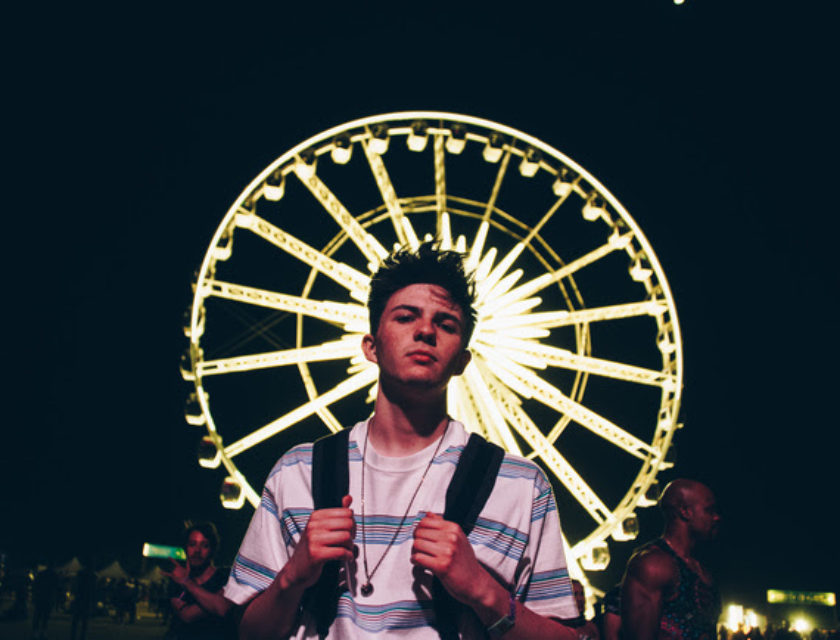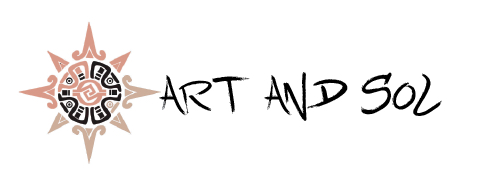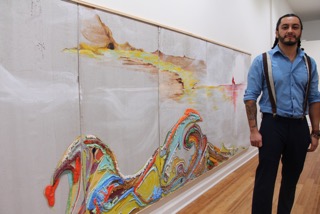The Mythology of Luis Sahagun
“Creativity takes courage”- Henri Matisse

Mexican-born Luis Sahagun has long been involved in creating. However, his self-discovery as an artist came as a late bloom in a lengthy journey. “I wasn’t completely naïve to being an artist, I was always a drawer,” describing his transition. Even in his early years as a sketch artist, Luis would find himself going through a few more with thoughts of becoming an architect or work in automotive body work. This, joined with prioritizing happiness, a career with the promise of money-making would lead him to choose product design as a major in college. “I was hard-headed cause I wanted to be a designer. I get to make things and get paid really well. You can make 6 figures within 5 years, you can be the guy that designs the next iPhone. It just seemed trendy; make money and be happy.” He goes on to say that it wasn’t without a passion for making that would allow him to continue this route. “In high school I used to be really good with fixing bodies of cars, painting them, making them look nice. I really loved it, and a professor [in high school] just motivated me to be more. When I found out what product design was, that was the first time there was a match. A match between working with my hands and I could have this academic degree that’s going to make me money and bring me a career.” Luis would find an opportunity to attend Southern Illinois University through the chance program, a two-semester extended academic transition for students who do not meet the standards for admission. After being undecided for two years, here he was still often recognized for his talent, “I could have been a minor in drawing cause I had to take so many art classes and everyone told me I was a sculptor; that I should be a sculptor.” Even after being encouraged to do more with his talent, he would still blow off the art thing. Still not to be deterred from his dream job working for a consulting firm, Luis would indeed find a career and adequate pay in design, but not the happiness he also sought.
“I enjoyed what I did cause I was doing drawings everyday. I was around these amazing objects, but there was something missing and I didn’t know what it was. It felt so superficial.” He never once mentioned his unhappiness stemmed from a difficult boss, long hours, or a bad benefit package; the cliché complaints of most millennials that move into the work force. “I worked there for almost a year and a half and that was when the recession affected me and I was part of a whole design team. At that time I didn’t want to be a designer anymore. It wasn’t for me. At least the field I was in.” When Luis made the decision to leave his well-paid and very interesting job, he was given a favorable severance package to settle his life and grudgingly stumble into the next phase of his life.
“I took an internship at a local gallery in Chicago Heights called Union Street Gallery, after not knowing what to do. I didn’t even know there was a gallery in my hometown.” He spent his days doing administrative work, shadowing artists, and learning a lot of the behind the scenes action that takes place in a gallery. It wasn’t until a helpful connection was made with a professor at Governors State University that would begin the bridge into pursuing an MFA. When speaking to Luis, his ability to tell his story in a seamless continuum is not overshadowed by the obstacle that it was to get to this next phase. He briefly talks of his battle with depression when he left his job and this empty space between his former employment into this internship. Its important to note that although it seems quite linear, going through the motions of what needs to be done vs. what he wanted to be done was a frequent imbalance for Luis and it would later play a role into his current works: unapologetically raw.
School, regrettably isn’t free. So with a handful of odd jobs, attending a few classes, and landing an assistantship, he managed to have the support of the school to assist him in tuition after a brief waiting period. It was here where his connection (turned mentor) helped him build a portfolio in order to obtain an MFA from NIU where he learned classical styles of painting.
His work ethic continues with the same quality as it did while attending college: persistent. He maintains that his handful of jobs and school attendance didn’t allow him the luxury of waiting around for a new idea. As he was driven by “moments in life that were particularly beautiful,” he realizes that it was somewhat of a consistent idea throughout this progress. “After learning more about myself and about what I make, now I work differently, now I know that it’s about that ‘moment’ and I try to (dissect) that moment. What am I trying to tell?”
Luis has had residencies in Oaxaca, Mexico and at the Roswell Artist in Residency in New Mexico. All of which gave him fresh perspective on his approach. “The reason why I wanted to tell stories was because for some reason when I was in grad school, I rejected stories. I started investigating stories; I thought it would be a challenge and it would also give meaning to the work I was doing.” He was allowed freedom to work at his pace without an agenda in a program that completely funded his lodging and materials. This gave him the inherent capacity to put together what would be his recent solo show at Kruger Gallery. “I like to try to push the idea of what art can be for me. Cause art did transform me, it gave me purpose, it made me happy. I wanted to get away with using art to connect with my family.” He goes on to describe connections he’s made with his parent’s infatuation or connections with certain animals with the hope that they would make the connection. His work at his Leyendas de un Bracero show immortalized fallen and imprisoned friends and family. The stories are in the work itself, which provides an illustrious mythology in the materials he uses and its visually raw finality. Any unsmooth edges, sketch marks, exposed hardware are all intentional and it gives his materials a different voice. “I believe materials should be truth. I’m not trying to fool anybody. You know its cement. Its important for me for materials to keep its identity.” He even goes as far as to bridge his materials to a deeper representation of himself and his existence. Although his identity is not fully discussed he touches on how his materials have dignity aside from just humble tools. “When I first started making artwork, I would associate being brown with cardboard; and maybe this idea of trying to dignify this piece of cardboard, materials already have dignity, people already have dignity. This is how I grew up, and maybe handling my materials that I’m not enough for this country…I’m just a guest. Yet these are enough, I don’t need to cast these in bronze or gold. This is a deep metaphor for having an unapologetic existence.”
Luis has already been working diligently on his next project that encompasses a theme of love. This includes rituals, prayers, and stories or a spiritual connection that he plans on turning into performance art. “I want to activate my sculptures. I want to inject meaning into them and right now I’m doing that with stories.” He describes what the performance would consist of with an invented ritual of his own making with the use of masks or an object in its place. “I would be creating a history, now its much more than an object. It now has a purpose for a ritual, and not a ritual for ritual’s sake but in my own twisted mind I believe in that ritual. That ritual is going to consist of a history of my own childhood.” A specific time in his childhood where, he battled what he called a “dark energy.” Or as his mom professed as “fighting with the devil,” acknowledging his connection to the spirit world. Something his family has said, he inherited from his grandmother. Expect for this exhibition to encompass experimental dance, allegorical use of the body, cultural and spiritual references with the use of his signature style sculptures.
His most recent show opened in January; and features works created in his time in New Mexico and indeed reference not just friends, but is a fitting representation of his experiences. Having spent time working in construction, his show title translates to “legends of a laborer.” His choice of materials are relative to that of a laborer or construction worker, but its his knowledge of his materials and how they are controlled is what truly makes it unique. Cement, wood, wax, large scale paintings are all that surrounds Kruger Gallery with an influence of Mexican heritage and a resonant voice for under-represented communities. Beauty and darkness, vibrancy and subtly, storytelling and visual aesthetic compel a viewer to the mythology that Is what his art represents.
Currently Luis works part time at the Museum of Contemporary Art, the Art Institute and weekends at a coffee shop where he is perfecting latte art. What I failed to mention is how he has managed to draw a favorable list of accomplishments along with this story full of art journey, in just 6 years. Luis has been accredited for winning best in show at Chicago’s School of Audio Engineering Institute’s Emerging Artists Exhibition in 2012, completing his year-long artist residency in Roswell, New Mexico in 2015-2016, and is currently a Bolt resident at Chicago Artists Coalition. Proof that there is unearthed talent that would require the kind of sacrifice that most of us would not have the courage to make. A consistent work ethic from idea to execution, and an ultimate goal to become a professor and a passion for his craft has allowed him to be as he describes, “content as a human being.”
His work is currently on display at Kruger Gallery in Lakeview until March 16th and select works will be on view at the National Museum of Mexican Art in late March.
To learn more about Luis Sahagun, visit his website www.luissahagun.com
Photos courtesy of Alex Ochoa
This article was originally from Halfstack Magazine’s Spring Issue 2017


Categories
Recent Posts
- Chuck D, Eminem, Perry Farrell and other artists join LeBron James, Doc Rivers, NBA, MLB, NFL, NHL & MLS arenas and teams to increase in-person voting options.
- Get Out & Vote – Wynwood Poster Campaign
- Karen O & Willie Nelson Cover “Under Pressure”
- SOFI TUKKER is FINALLY Coming To the US – and There’s a New Video!
- The Big Weekend! Five Venues – 3 Nights










Recent Comments